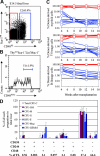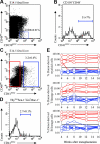Enhanced purification of fetal liver hematopoietic stem cells using SLAM family receptors
- PMID: 16569764
- PMCID: PMC1895480
- DOI: 10.1182/blood-2005-10-4135
Enhanced purification of fetal liver hematopoietic stem cells using SLAM family receptors
Abstract
Although adult mouse hematopoietic stem cells (HSCs) have been purified to near homogeneity, it remains impossible to achieve this with fetal HSCs. Adult HSC purity recently has been enhanced using the SLAM family receptors CD150, CD244, and CD48. These markers are expressed at different stages of the hematopoiesis hierarchy, making it possible to highly purify adult HSCs as CD150(+)CD48(-)CD244(-) cells. We found that SLAM family receptors exhibited a similar expression pattern in fetal liver. Fetal liver HSCs were CD150(+)CD48(-)CD244(-), and the vast majority of colony-forming progenitors were CD48(+)CD244(-)CD150(-) or CD48(+)CD244(+)CD150(-), just as in adult bone marrow. SLAM family markers enhanced the purification of fetal liver HSCs. Whereas 1 (11%) of every 8.9 Thy(low)Sca-1(+)lineage(-)Mac-1(+) fetal liver cells gave long-term multilineage reconstitution in irradiated mice, 1 (18%) of every 5.7 CD150(+)CD48(-)CD41(-) cells and 1 (37%) of every 2.7 CD150(+)CD48(-)Sca-1(+)lineage(-)Mac-1(+) fetal liver cells gave long-term multilineage reconstitution. These data emphasize the robustness with which SLAM family markers distinguish progenitors at different stages of the hematopoiesis hierarchy and enhance the purification of definitive HSCs from diverse contexts. Nonetheless, CD150, CD244, and CD48 are not pan-stem cell markers, as they were not detectably expressed by stem cells in the fetal or adult nervous system.
Figures





References
-
- Muller AM, Medvinsky A, Strouboulis J, Grosveld F, Dzierzak E. Development of hematopoietic stem cell activity in the mouse embryo. Immunity. 1994;1: 291-301. - PubMed
-
- Cumano A, Dieterlen-Lievre F, Godin I. Lymphoid potential, probed before circulation in mouse, is restricted to caudal intraembryonic splanchnopleura. Cell. 1996;86: 907-916. - PubMed
-
- Medvinsky A, Dzierzak E. Definitive hematopoiesis is autonomously initiated by the AGM region. Cell. 1996;86: 897-906. - PubMed
-
- Gekas C, Dieterlen-Lievre F, Orkin SH, Mikkola HK. The placenta is a niche for hematopoietic stem cells. Dev Cell. 2005;8: 365-375. - PubMed
-
- Ottersbach K, Dzierzak E. The murine placenta contains hematopoietic stem cells within the vascular labyrinth region. Dev Cell. 2005;8: 377-387. - PubMed
Publication types
MeSH terms
Substances
Grants and funding
LinkOut - more resources
Full Text Sources
Other Literature Sources
Medical
Research Materials
Miscellaneous

